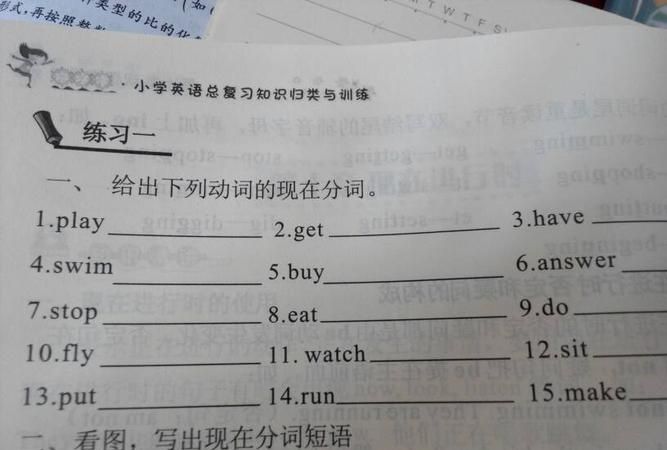本文目录
我现在上六年级了用英语怎么说
现在分词最典型的形式就是:be doing。be就是指is,am are,doing就是在动词后面加ing或双写动词结尾加ing或以不发音的e结尾的去e加ing。你首先应该消化这些知识。那么,判断句子中是否应该使用ing,可以先找“now”(现在)“look”(看)“listen”(听)等表正进行的单词,还可以翻译句子,理解句子中的动作是不是正在进行的。例如:
I am dancing.
She is singing
He is playing games.
They are running.
We are swimming.
总结来看。。现在分词就是动词ing。这个不知道能不能听懂。你可以问度娘什么是现在分词或者问一下老师,这是基础,一定要学好的。祝你学业进步。

type的现在分词是什么意思
type的过去分词是typed。
type[英][taɪp][美][taɪp]
n.类型; 铅字; (印刷或打印的)文字; 于…类型的;
vt.& vi.打字;
vt.[医学]测定(血型); 按类型把…归类; 成为…的典型; [印刷]浇铸(铅字等);
第三人称单数:types过去分词:typed复数:types现在进行时:typing过去式:typed。

现在分词和过去分词的语法功能
我给你找了点这方面的讲义 其实很好懂的 两者就是时态的区别 表示过去或将来正进行的一种状态 具体的 看下下面的 满意的话 采纳给个好评吧 我在完成任务 谢谢了
现在分词和过去分词
一、 注意点
1、 否定形式(前面加not)
Not given a chance, he felt disappointed.
Not knowing what to do, he turned to me for help.
2、 不及物动词、连系动词常用现在分词做定语、状语等;及物动词常用过去分词。
There are many events happening in the world everyday.
provide help for the people going hungry.
the remaining books
3、 现在分词表动作的主动或正在发生;过去分词表动作的被动或已经完成。
the falling/ fallen leaves the boiling/ boiled water the rising/ risen sun
the developed/ developing countries a polluted river a sleeping boy
4、 分词不具有名词特征,不可做主语或宾语。(定语、表语、状语、宾补/主补)
Participating in various social activities is beneficial to our future. (动名词)
Praised in public made him shy. (错)
Being praised in public made him shy.
二、 做定语/表语
1、 和定语从句的转换
The student who is sleeping has suffered a high fever.
The sleeping student has suffered a high fever.
Those who have drunk the water which is polluted may get poisoned.
Those who have drunk the polluted water may get poisoned.
2、单个分词做定语常置于名词之前;分词短语常置于名词之后。
Do you know the man seated/ sitting next to the professor?
The man looking at the map has got lost.
The building completed ahead of time has caught many people’s attention.
比较:The building being built has caught many people’s attention.
The building to be built next year is well designed.
3、现在分词和动名词做定语时的区别
a reading room (动名词) a swimming pool(动名词) a crying baby(现在分词) a washing machine(动名词)
4、使役动词的分词形式做定语或表语时,常遵循人V-ed,物V-ing的原则,但修饰反映人心理活动或某种情绪的词时,用V-ed形式.
encouraging words an embarrassing atmosphere feel embarrassed be shocked
excited tears a surprised/ determined/ frightened look
After hearing my encouraging words, a determined look appeared on his face.
5、 修饰令他人有某种情绪的词时,无论人还是物均用V-ing.
The disappointing student has disappointed his parents a second time.
6、 有些分词已经形容词化了
a demanding job a promising teacher an interesting book
三、做状语(时间、原因、条件、让步、方式、伴随或结果状语)
1、强调前后主语的一致。
Seen from the hill, I find our school small.(错)
Seen from the hill, our school looks small.
Seeing from the hill, I find our school small.
2、 原因、时间、条件、让步、方式状语常置于句首,不强调动作先后时遵循主动V-ing被动V-ed。
Given more time, I could do better.
Being too fat, you should take regular exercise to lose weight.
Determined to catch up with others, he works day and night.
Walking in the street, I came across an old friend.
3、 若有时间先后,可借助having
Having failed many times, he made up his mind to go abroad for further education.
Having been shown around Tian’anmen Square, the tourists were taken to visit the Palace Museum.
Not having met him before, I’m very curious.
4、 伴随状语常置于句末
They’re still sitting on the sofa, absorbed in conversation.
The students are riding on the street, talking and laughing.
5、 结果状语常置于句末,典型例子making, leaving, causing
They all left, leaving me standing there alone.
English is spoken by many people in various countries, making it the most popular language in the world.
比较:不定式做结果状语
He went abroad, never to return.
They lifted a rock, only to drop it on their own feet.
四、 做宾补常用于以下结构
1、 see/ hear/ watch/ notice/ find/ feel + sb + 分词
I saw a book lying there
A book was seen lying there.
He found his hometown greatly changed after many years.
2、 leave/ keep + 宾语 + 分词
A flood hit the area the other day, leaving few houses standing.
I am sorry to have kept you waiting for so long.
3、have/ get +宾语 + 分词
It is time that you had your washing machine repaired.
I can’t get my car going.
I will try my best to get my English improved.
4、catch/ send sb doing →be caught/ sent doing
The girl who was caught cheating has admitted her mistake.
A sudden rain sent the players and the audience running in all directions for cover.
5、with+ 宾语+ 分词
With the population growing rapidly, we need more living materials.
With green trees surrounded, it is really a good place to live in.
With the fellow leading the way, we had no trouble finding the temple.
五、 前后主语不一致时,可用独立主格结构
Weather permitting, we will hold the sports meeting.
Money collected, we set about carrying out the plan.
The sun risen, everything looks beautiful.
There being 阿 heavy rain, we had to have a break.
六、 一些常用固定结构
judging from/ by…
considering…
compared with…
to tell you the truth…
generally speaking…
speaking of…
including…/included
Judging from his look, we thought he was badly hurt.
Considering the present economic situation, you should cut back on your expenses.
Speaking of factories, people often think of air and water pollution.
Compared with the students in the remote mountainous areas, you are so lucky.
Many a student has made great progress, including some naughty ones.
七、 拓展:there be结构和非谓语动词的连用。
1、There be… + doing/ done/ to do
There are large areas polluted by industrial waste.
There used to be many birds flying in the blue sky.
What troubles him these days is that there are too many things to do.
2、动词+ there to be/ there being…如expect/ want/ like/ hate/ mind/ imagine等
As senior middle school students, we expect there to be more free time to relax ourselves.
Do you mind there being two more students in your class?
3、句型It is + adj.+ for + there to be…
It is common for there to be a misunderstanding between teachers and students.

burning的动词形式
burning 在这个句子当中是一个典型的现在分词,表示事物所处的状态。
而动名词的词性还是偏向名词而不是动词的性质,keep the lights burning,已经有lights这个名词,后面要作为现在分词修饰灯光的状态才比较合适。
Reading is good for us.
在这个句子中,reading就是作为动名词而存在。

以上就是关于典型的现在分词 ,我现在上六年级了用英语怎么说的全部内容,以及典型的现在分词 的相关内容,希望能够帮到您。
